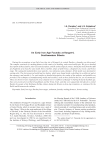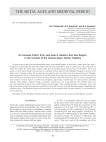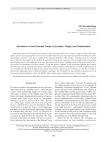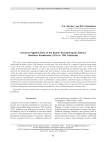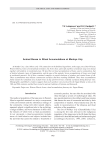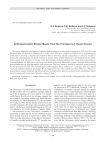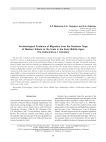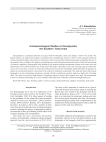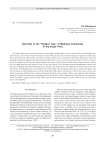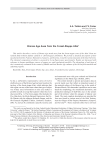The metal ages and medieval period. Рубрика в журнале - Archaeology, Ethnology & Anthropology of Eurasia
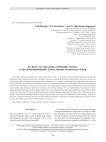
An early iron age camp of reindeer hunters in the Bolshezemelskaya tundra, Nenets autonomous okrug
Статья
Бесплатно
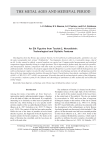
An elk figurine from Tourist-2, Novosibirsk: technological and stylistic features
Статья
Most fi gurines from the Bronze Age cemetery Tourist-2 in Novosibirsk are anthropomorphic, and follow one and the same iconographic style, termed “Krokhalevka”. Two fragments, however, refer to a zoomorphic image—that of an elk. As they cannot be refi tted, a special analysis was carried out. Computer-aided measurements and statistical comparisons suggest that they belong to a single specimen. This is important for further study, the search for parallels, and interpretation. Stylistic comparison with other items of portable art from Tourist-2 is diffi cult, since these are anthropomorphic. Nonetheless, the analysis suggests that the elk fi gurine is a perfect match with the homogeneous and stable technological complex revealed by other specimens. In terms of technology and style, the elk fi gurine parallels those of the Late Angara fi gurative tradition. Because the Tourist-2 burial had not been dated, a preliminary AMS-date of 4601 ± 61 BP (3511–3127 cal BC) was generated. Given this date and the archaeological context of the elk fi gurine, it can provide a reference point for the cultural and chronological attribution of other stylistically and technically similar images.
Бесплатно
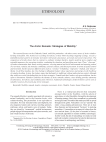
An old Turkic statue at Borili, Ulytau hills, Central Kazakhstan: cultural realia
Статья обзорная
Бесплатно
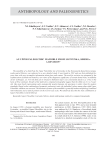
An upper Paleolithic mandible from Listvenka, Siberia: a revision
Статья научная
The mandible of a child from the Upper Paleolithic site of Listvenka in the Krasnoyarsk-Kansk forest-steppe, south-central Siberia, was subjected to a new detailed study. It was found in 1992 and was first published five years later with very incomplete information about place and context. The need for revision was prompted by the sophistication of dental trait batteries, new views of the diagnostic signifi cance of certain dental traits, availability of new techniques, etc. Now the fi nd can be related to habitation layer 12d, consistently dated to ca 13 ka on the basis of three estimates. Results of the multi-slice computed tomography suggest that the child was 3.5–4.5 years old. Like most fossils representing early anatomically modern humans, the specimen is rather robust by modern standards. Based on the combination of nonmetric and metric traits, the individual's place among other eight Upper Paleolithic children was assessed. The distinctive feature of the mandible is generally modern morphology combined with robusticity and a neutral position on the west-to-east scale. We tentatively describe this trait combination as Upper Paleolithic Central Siberian.
Бесплатно
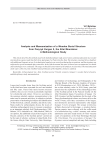
Статья научная
This article describes the methods used in the multidisciplinary study, preservation, and museumization of a wooden structure from a grave under the Early Iron Age kurgan 5 at Pazyryk in the Altai. The structure consisted of two chambers with additional elements on top. Its technological analysis was carried out during the excavations, and the structure was subjected to special treatment after extraction. At the side the mound, the outer cribwork was reconstructed; its details and technologies were evaluated. The stages in the field conservation of all artifacts are described. The museumization of the outer cribwork at the Anokhin National Museum of the Republic of Altai is outlined.
Бесплатно

Статья научная
This article presents the findings of the study of a co-burial of a eunuch-official and his wife, found in the city of Uijeongbu, Gyeonggi-do Province, made in accordance with Confucian traditions during the Joseon Dynasty period. A description of finds, perfectly preserved in the grave sealed with lime-soil mixture and charcoal barrier, is given. The writings on the banners draping the coffins are studied. These say that in the left coffin the husband named Lee was buried; he was an official who oversaw the management of palace goods and held the position that was given only to eunuchs. In the right coffin, according to the writing, there was the body of the wife; she was awarded a lady's rank corresponding to her husband's status. Special focus is given to the description of clothes and fabric on the bodies of the buried. The results of anthropological analysis of the remains are given. Morphological features of the pelvic and skull bones provided the information on the sex of the deceased. According to the condition of the auricular surface of the left pelvic bone, the age of the eunuch-official and his wife was determined as more than 60 years. It is concluded that the research materials significantly supplement the scientific information on the position of eunuch-officials in the society during the Joseon Dynasty period.
Бесплатно
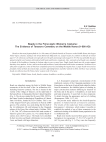
Статья научная
Beads are the most frequent finds in 1st–5th century AD female burials at Tarasovo on the Middle Kama, the largest Finno-Ugric cemetery, dating to the Great Barbarian Migration era. Larger beads are common in burials of women aged 17–45, whereas seed beads were typically worn by girls and young women aged 13–29. This was probably because unmarried girls wore beanies embroidered with beads and bronze ornaments. Also, variously sized beads were attached to bands of the headdress, framing its bottom edges in one or more lines. Single beads found near the crania suggest that they were amulets. In one- and several-strand necklaces, beads alternated with bronze ornaments. Necklaces were often parts of gift sets, some of which are completely preserved, including the organic base. Larger beads were used as pendants. Some of them decorated strips, used for appending knives and other utensils to belts. All these ways of using beads are still practiced by Finno-Ugric women in the Ural area.
Бесплатно
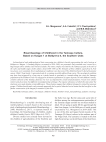
Статья научная
Archaeological and anthropological data concerning two children’s burials representing the early horizon at Boldyrevo-4 kurgan 1, Orenburg Region, excavated in 2019–2020, are presented. Early mounds were covered by a huge kurgan above another, later burial of adults. The entire complex was built by the Yamnaya people at the turn of the early and middle stages of this culture, about 3300–3100 cal BC. Remains of three children, aged about 6, from two graves, were examined. Severe pathological conditions were discovered. The child from burial 3 died of metastatic cancer. Child 1 from burial 4, represented only by a cranium, possibly suffered from scurvy. The oncological condition may have been triggered by a long stay at a smoky hearth or proximity to a metalworking site, since the Yamnaya population of the Southern Urals was engaged in an intense exploitation of copper deposits. In both children’s burials, common elements of the Yamnaya funerary rite were accompanied by certain unusual features. Vessels were similar in form and decoration, but different in manufacturing technique. The organic substances of which the mats under the skeletons were made display certain differences. These features suggest that children belonged to related but separate groups. Children buried under early mounds apparently had a special inherited social status that had an effect on the further construction of the kurgan for members of the elite.
Бесплатно
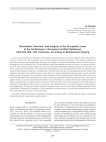
Статья научная
Science-based studies at Gordinskoye I (Guryakar) fortified settlement in northern Udmurtia (9th–13th centuries AD) were carried out. The occupation layer had been largely destroyed by plowing. The statistical analysis of multispectral images and segmentation of the generated images of vegetation distribution make it possible to assess the integrity of the occupation layer. The preliminary conclusion about the presence of its parts, varying in thickness, is based on the analysis of the configuration of areas of segmented multispectral images and the correspondence of diverse segments to relief features. Assessment of archaeological context and of the preservation of occupation layer (superficially disrupted, replaced, or transported) is possible only with the use of geophysical and soil studies and targeted excavations. The available reference data allow us to interpret individual segments present solely on the flat surface of the promontory. The assessment of the parameters of the occupation layer within the entire survey area is possible through the extrapolation of properties of vegetation segments with known characteristics. Based on the totality of data, it can be assumed that the built-up area of Guryakar was limited by the outer fortification line. A thick occupation layer is localized on the promontory, within two inner structural parts of the site. Two other parts of Guryakar, situated between the residence area and the outer fortification line, were probably used for utility purposes and manufacture. The deposition of the medieval occupation layer was less intense there. Additional markers of the fortifications, delimiting the boundaries of the settlement’s structural parts, are vertically oriented linear areas of the transported layer on slopes of the promontory.
Бесплатно

